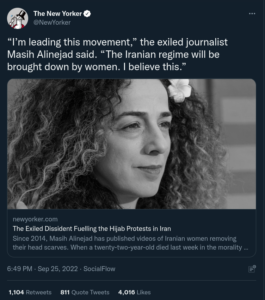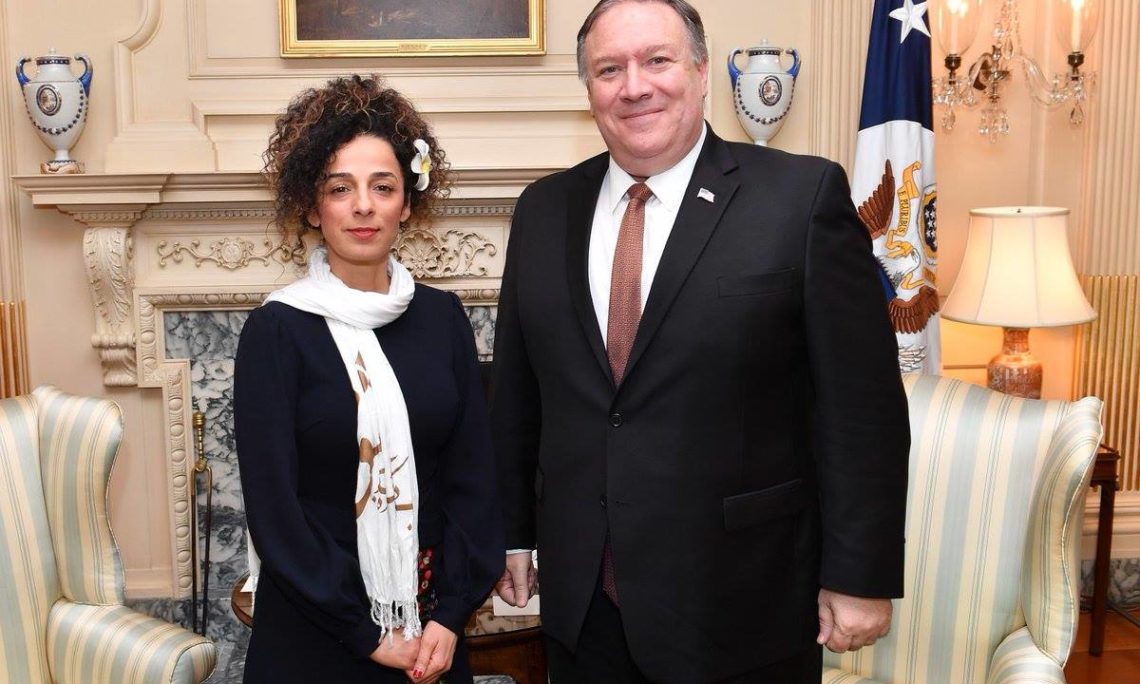On September 24th, the New Yorker published an interview with Iranian journalist Masih Alinejad titled “The Exiled Dissident Fueling the Hijab Protests in Iran.” The New Yorker tweeted a promotion for the report with a quote from Alinejad: “I am the leader of this movement.” Within a few hours of this tweet, the article received widespread condemnation by Iranians in and outside of Iran. Alinejad tweeted there was a misunderstanding and was explaining that her anti-hijab protests simply “inspired” the protests. She asked the New Yorker to clarify this. She added in a follow-up tweet that “the real leaders of [the current] anti-regime movements are inside the country.” As of Oct 4th, the New Yorker has not made any corrections.
Even in her “clarification,” Alinejad maintained her centrality to the movement. By claiming she’s its “inspiration,” Alinejad omits that the Woman, Life, Freedom movement existed long before her and will exist without her. She takes advantage of her Western audience, unfamiliar with Iran but trying to understand what’s happening. By reducing the historical struggle for women’s liberation to a few anti-Hijab campaigns, her egotistical, circular logic still crowns her the “leader.” Alinejad actively suppresses over a century of active struggle by the Iranian women, predating the 1905 Constitutional Revolution and continuing to today. Only a few months after the collapse of the Pahlavi Dynasty, women were faced with a return to subservience, Khomeini was threatening that should he consolidate power, the hijab would become mandatory. Iranian women poured into the streets on March 8th, 1979, chanting, “we did not make a revolution to go backward,” (ما انقلاب نکردیم تا به عقب برگردیم) and “Freedom is universal, not Eastern nor Western” (آزادی، نه شرقی، نه غربی، جهانیست). These nationwide protests took about five days, during which women led a national general strike. This forced the Islamic party to delay its implementation. Less than a year later, the mandatory Hijab began creeping into life. Women working in the public sector were required to wear a hijab, and the mandate slowly grew to encompass all women in 1982. This was only accomplished once the counter-revolutionary Islamic party seized power and purged the nation of revolutionary organizations and activists.
Despite this, women have continued to struggle for equal rights (including against the compulsory hijab) both individually and collectively. Alinejad refuses to recognize this continuous struggle and resistance. Karim Sadjadpour, a researcher at the Carnegie Endowment for International Peace in Washington, D.C, attempts to hide her blatant opportunism by adding to her New Yorker puff piece that “For three decades, Iranian women endured daily indignities and had no recourse, [But] today, they can film their harassers and abusers and send it to Masih, and millions of people will see it.” Both Sajjadpour and Alinejad depict Iranian women as helpless victims to portray Alinejad as a Western liberator. She did not rename herself “Masih” (literally “messiah/Christ”) for nothing.
Masih Alinejad obscures her background, nor does the New Yorker investigate her credentials. She portrays herself as a journalist forced to flee the country because of the harassment subjected by the Iranian authorities put on her. In 2014 she heroically began using social media to “pressure” the Iranian government from the comfort of her new home in New York. She hides in her interview that until 2017 she supported reformist efforts within Iran, attacking anyone who called for the Islamic Republic’s downfall and downplaying criticism of the mandatory hijab. Only after the thorough destruction of the reformist movement did she become a regime change advocate and women’s rights crusader. Seventeen years earlier, Hassan Yousefi-Ashkevary, a cleric close to the national-religious factions, was sentenced to death for criticizing the mandatory hijab at a Berlin conference. If her history was mentioned in the article, Alinejad’s credibility would fold like a paper tiger.
Similarly, Alinejad omits the large swath of Iranian feminists that condemn her and her opportunistic politics. On May 13th, 2019, protestors at the University of Tehran chanted, (علینژاد و ارشاد/ ارتجاع و انقیاد) “Both Alinejad and the morality police [are the figures of] reactionism and subjugation.” Although these protests met with government suppression, students rejected carpetbagger Alinejad and her attempts to hijack their movement.
Most importantly, Alinejad hides that the initial organizers and activists of the Woman, Life, Freedom uprisings—in Tehran under the title of “a group of women activists in Tehran” and in Rasht “a group of activists in Rasht”—are wholeheartedly opposed her. Indeed, Alinejad takes advantage of the feminist activists who work underground for safety reasons, fraudulently using these protests to market herself. That she platforms reactionary slogans like “Reza Shah, may your soul be blessed” (رضا شاه روحت شاد) “We did wrong to revolt against the Shah” (ما انقلاب کردیم چه اشتباهی کردیم) only demonstrates her chauvinism. The strength of the current protests in Kurdistan and Baluchistan (and the repression used) compared to other regions exposes the necessity of a new regime addressing widespread ethnic discrimination.
It must be noted that the main slogans of these current demonstrations—”Woman, life, freedom,” “bread, jobs, freedom, optional clothing,” (نان کار آزادی پوشش اختیاری) and “down with the tyrant, either Shah or the supreme leader” (مرگ بر ستمگر چه شاه باشه چه رهبر)—repudiate Alinejad and her allies. Once Trump entered office, she became a staunch supporter of the restoration of the Pahlavi monarchy. Moreover, she is a rabid supporter of sanctions, meeting with Mike Pompeo to advocate for harsher sanctions while using any opportunity to cheerlead the existing cruel sanctions against the Iranian people. Likewise, Alinejad’s employment by Voice of America was hidden by the author until a public letter condemning this article forced the editor to issue this “correction.” Combined with the barbarous neoliberal policies and widespread corruption of the Iranian regime, the Iranian people face unprecedented levels of poverty. Alinejad has not once recoiled at the economic devastation Iranians face, gleefully seeing starvation and the absence of medical care as a well-deserved collective punishment. Nor has she flinched at the reactionary, Christian fundamentalist beliefs of her coworkers Mike Pompeo and Pat Toomey, which call for a similar level of gender and queer subjugation in the U.S. She has no issue with reactionary, misogynistic, backward laws hindering women’s and queer liberation if it gets her a job.
That Alinejad’s shameless opportunism made it past the editor’s desk at the New Yorker calls into question the integrity of the magazine’s principles. Beyond sloppy journalism, her interview does nothing but reinforce orientalist ideas that non-western people passively accept oppression until the West brings them freedom. It should be remembered the support the United States provided to the brutal Pahlavi dynasty and its early support for the Islamic Republic through arms deals. The Iranian people resisting oppression reject Alinejad and her backers…




Comment here